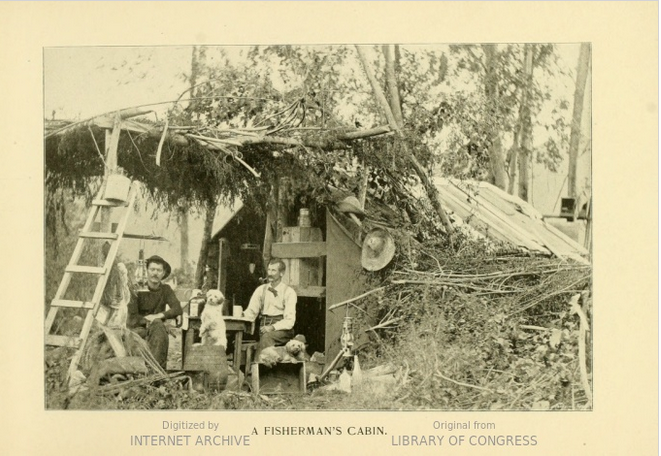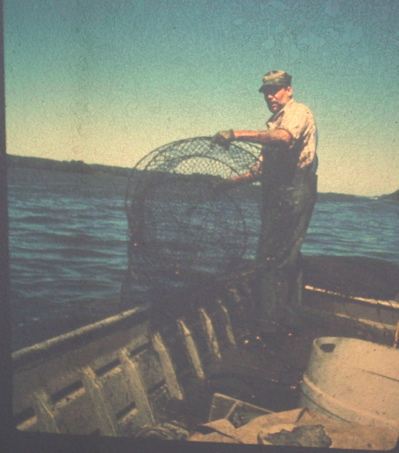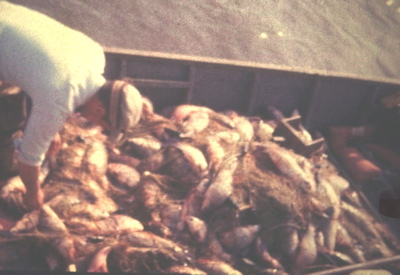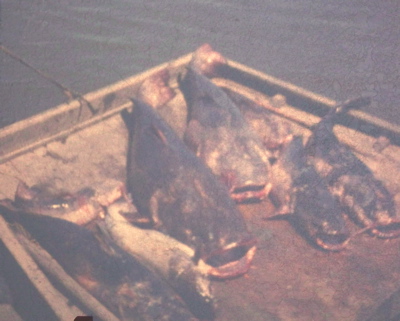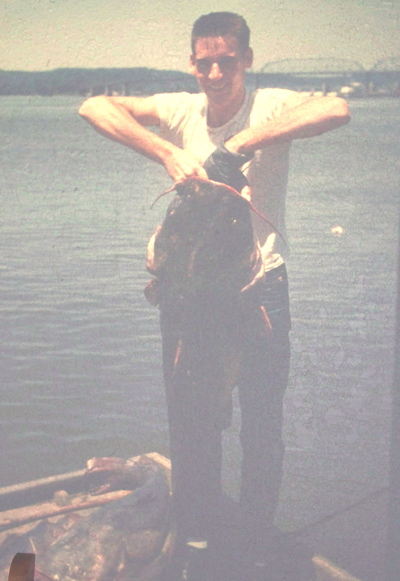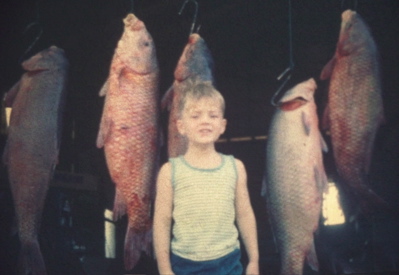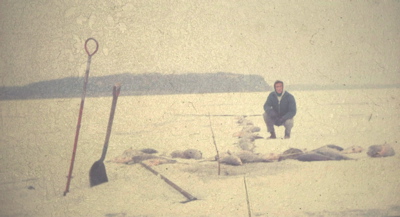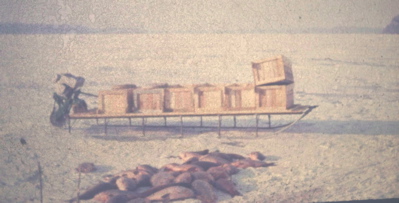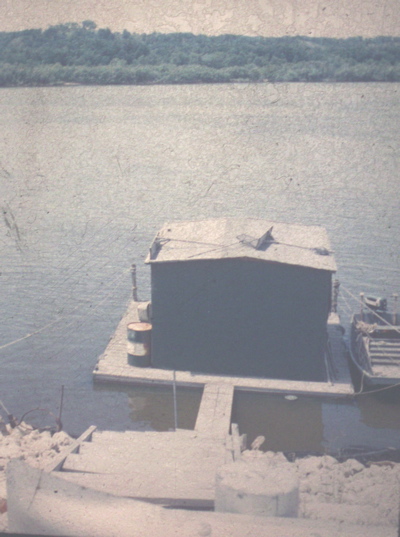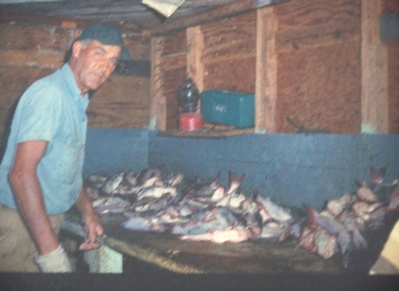Encyclopedia Dubuque
"Encyclopedia Dubuque is the online authority for all things Dubuque, written by the people who know the city best.”
Marshall Cohen—researcher and producer, CNN
Affiliated with the Local History Network of the State Historical Society of Iowa, and the Iowa Museum Association.
COMMERCIAL FISHING: Difference between revisions
No edit summary |
No edit summary |
||
| Line 6: | Line 6: | ||
Fisherman in 1911 lobbied the Iowa legislature for changes which they announced could make fishing along the Mississippi worth an estimated $4,000 per mile. The first request was removing the prohibition on the trammel net which would improve fishing for carp and [[STURGEON]]. Cheap to buy and easily operated by one person, the claim was made that in fishing the channel no game fish would be caught. The fisherman also requested that the only restriction upon the kind of fish that could be harvested would correspond to the weight of the fish at "their maturity." Believing that the 'removal of one mature fish for this reasons means the preservation of scores of young fish" the change would mean that carp could be caught over 2.5 pounds, buffalo at 2.5 pounds, sand sturgeon at 1.0 pounds, rock sturgeon at 2.0 pounds, black bass at 1.0 pounds, striped bass at .5 pounds, crappies at .5 pounds, pike at 1.0 pounds, and pickerel at 1.5 pounds. For these changes, fisherman getting their license would agree to help conservation officers seine small fish caught in shallow ponds and move them to deeper water and/or dig channels for the young fish to swim to safety. (3) | Fisherman in 1911 lobbied the Iowa legislature for changes which they announced could make fishing along the Mississippi worth an estimated $4,000 per mile. The first request was removing the prohibition on the trammel net which would improve fishing for carp and [[STURGEON]]. Cheap to buy and easily operated by one person, the claim was made that in fishing the channel no game fish would be caught. The fisherman also requested that the only restriction upon the kind of fish that could be harvested would correspond to the weight of the fish at "their maturity." Believing that the 'removal of one mature fish for this reasons means the preservation of scores of young fish" the change would mean that carp could be caught over 2.5 pounds, buffalo at 2.5 pounds, sand sturgeon at 1.0 pounds, rock sturgeon at 2.0 pounds, black bass at 1.0 pounds, striped bass at .5 pounds, crappies at .5 pounds, pike at 1.0 pounds, and pickerel at 1.5 pounds. For these changes, fisherman getting their license would agree to help conservation officers seine small fish caught in shallow ponds and move them to deeper water and/or dig channels for the young fish to swim to safety. (3) | ||
The trammel net issue was not approved and commercial fisherman were still hoping to get the regulations changed in 1926. (4) | |||
In 1980, 754 fishermen reported commercial catches along the Iowa shoreline. This number, triple the number reported in the 1960s according to conservation officials, was due primarily to an increase in the number of part-time fishermen. Fish production in the states of Iowa, Illinois, Minnesota, Missouri, and Wisconsin has remained fairly constant at an estimated eleven million pounds annually with a value of $1.2 million. | In 1980, 754 fishermen reported commercial catches along the Iowa shoreline. This number, triple the number reported in the 1960s according to conservation officials, was due primarily to an increase in the number of part-time fishermen. Fish production in the states of Iowa, Illinois, Minnesota, Missouri, and Wisconsin has remained fairly constant at an estimated eleven million pounds annually with a value of $1.2 million. | ||
Statistics hide a gradual decline in the catches reported due to pollution, silting and over-fishing. The largest decline reported was in the number of catfish caught. | Statistics hide a gradual decline in the catches reported due to pollution, silting and over-fishing. The largest decline reported was in the number of catfish caught. The year 1966 marked the lowest number of this valuable fish being caught in three decades. Concern was so high, that conservation officials closed the season two weeks earlier than usual.(5) Catches in 1980 were 85 percent lower than the amount reported in 1965. Catfish have accounted for as much as one-third of a commercial fisherman's income leading to demands that size limits on catfish not be raised. Pools with the largest surface area annually reported the largest catches. | ||
One of the successful commercial fishing families in Dubuque were the Duccinis--Fred; his son, Walter; his grandson, John; and for many years, Tom. Fishing a territory seven miles above and seven miles below Dubuque, the three generations run hoop nets, wooden box traps, trammel nets, gill nets and seines profitably for decades while also holding down other jobs at the packing company or The Adams Company. The self-described "cut-throat competition" of the industry led the family to often work at night. This avoided letting others know the best places to fish or the most efficient methods to use. Catches were brought in early in the morning; family members were involved in cleaning fish before they left for school. Tom Ducccini, a member of the [[HEMPSTEAD HIGH SCHOOL]] football team remembered coming to practice with a bandaged finger and needing to explain to a worried coach that he had been horned while cleaning a catfish that morning. | One of the successful commercial fishing families in Dubuque were the Duccinis--Fred; his son, Walter; his grandson, John; and for many years, Tom. Fishing a territory seven miles above and seven miles below Dubuque, the three generations run hoop nets, wooden box traps, trammel nets, gill nets and seines profitably for decades while also holding down other jobs at the packing company or The Adams Company. The self-described "cut-throat competition" of the industry led the family to often work at night. This avoided letting others know the best places to fish or the most efficient methods to use. Catches were brought in early in the morning; family members were involved in cleaning fish before they left for school. Tom Ducccini, a member of the [[HEMPSTEAD HIGH SCHOOL]] football team remembered coming to practice with a bandaged finger and needing to explain to a worried coach that he had been horned while cleaning a catfish that morning. | ||
| Line 40: | Line 42: | ||
3. Ibid. | 3. Ibid. | ||
4. "Commercial Fishing Around Dubuque is over for This Season," ''Telegraph Herald'', November 22, 1926, p. 3 | |||
5. "There'all Always be Catfish," Florence Shippley, '''Telegraph Herald,''' November 5, 1967. p. 9 | |||
Commercial Fishing. YouTube user:10qia3AZ1mc | Commercial Fishing. YouTube user:10qia3AZ1mc | ||
Revision as of 20:43, 13 December 2020
COMMERCIAL FISHING. According to the Dubuque Herald on January 2, 1874, the commercial fishing was the best it had ever been on record. Using a seine three hundred yards long, Ernest Wiedner of Dubuque caught 50,000 pounds of fish at a spot near Lansing. The seine was drawn to the shore under the ice and then five days were needed to dip the fish out with hand-nets through holes in the ice. One sportsman was reported to have caught 250 pounds of walleye pike in one day through holes he cut in the ice along the shore. (1)
By 1911 the annual catch reached millions of pounds of fish with most shipped the New York City. One single haul of fish made on the Mississippi filled three railroad cars and resulted in $2,000 being paid to the fishermen who caught it. One twenty-mile section of the MISSISSIPPI RIVER resulted in payments to fishermen of an estimated $2,500 per mile. The entire river along Iowa's eastern border was thought to yield even better financial rewards. (2)
Fisherman in 1911 lobbied the Iowa legislature for changes which they announced could make fishing along the Mississippi worth an estimated $4,000 per mile. The first request was removing the prohibition on the trammel net which would improve fishing for carp and STURGEON. Cheap to buy and easily operated by one person, the claim was made that in fishing the channel no game fish would be caught. The fisherman also requested that the only restriction upon the kind of fish that could be harvested would correspond to the weight of the fish at "their maturity." Believing that the 'removal of one mature fish for this reasons means the preservation of scores of young fish" the change would mean that carp could be caught over 2.5 pounds, buffalo at 2.5 pounds, sand sturgeon at 1.0 pounds, rock sturgeon at 2.0 pounds, black bass at 1.0 pounds, striped bass at .5 pounds, crappies at .5 pounds, pike at 1.0 pounds, and pickerel at 1.5 pounds. For these changes, fisherman getting their license would agree to help conservation officers seine small fish caught in shallow ponds and move them to deeper water and/or dig channels for the young fish to swim to safety. (3)
The trammel net issue was not approved and commercial fisherman were still hoping to get the regulations changed in 1926. (4)
In 1980, 754 fishermen reported commercial catches along the Iowa shoreline. This number, triple the number reported in the 1960s according to conservation officials, was due primarily to an increase in the number of part-time fishermen. Fish production in the states of Iowa, Illinois, Minnesota, Missouri, and Wisconsin has remained fairly constant at an estimated eleven million pounds annually with a value of $1.2 million.
Statistics hide a gradual decline in the catches reported due to pollution, silting and over-fishing. The largest decline reported was in the number of catfish caught. The year 1966 marked the lowest number of this valuable fish being caught in three decades. Concern was so high, that conservation officials closed the season two weeks earlier than usual.(5) Catches in 1980 were 85 percent lower than the amount reported in 1965. Catfish have accounted for as much as one-third of a commercial fisherman's income leading to demands that size limits on catfish not be raised. Pools with the largest surface area annually reported the largest catches.
One of the successful commercial fishing families in Dubuque were the Duccinis--Fred; his son, Walter; his grandson, John; and for many years, Tom. Fishing a territory seven miles above and seven miles below Dubuque, the three generations run hoop nets, wooden box traps, trammel nets, gill nets and seines profitably for decades while also holding down other jobs at the packing company or The Adams Company. The self-described "cut-throat competition" of the industry led the family to often work at night. This avoided letting others know the best places to fish or the most efficient methods to use. Catches were brought in early in the morning; family members were involved in cleaning fish before they left for school. Tom Ducccini, a member of the HEMPSTEAD HIGH SCHOOL football team remembered coming to practice with a bandaged finger and needing to explain to a worried coach that he had been horned while cleaning a catfish that morning.
John, Tom's father, began working in the business around the age of five. Trot lines carried one hundred hooks each. As they were brought out of the water, the fish were removed from the hooks and dumped into tubs. Lines had be wound carefully to avoid a mess. John ran trot lines for four years or until he was about eighteen. By then he had also had plenty of experience with "bank work" which included cleaning, boxing, and icing the fish for market. When he was in his teens, fishermen looked for trucks every three days to pick up their catch. They paid the drivers from 5-10 cents per pound to haul the fish to Chicago. Around 1990 as the price of fish dropped, families like John's packed fish in fifty gallon barrels, iced them, and drove to Savanna to sell their catch. Fish were sold to primarily to Chicago and New York, although the Duccinis once filled orders from Jerusalem. Fishermen in the Dubuque area suffered somewhat from their position on the river. Since the river was open further south, fisherman there made larger catches. Dubuque-area fishermen had to wait until the ice melted before returning to some of their better methods like hoop nets.
John Duccini learned the fishing trade from his father. Signs in nature indicated when fish would probably be spawning. Lilacs in bloom meant it was time for carp. The snowy cottonwood predicted catfish spawn. When he was old enough to handle the business, his father gave John one-quarter of the profit for five years or until he had woven one hundred hoop nets. Working in the basement at night, John could manage to make about twenty-five nets per year. When the one hundred figure was reached, he shared in fifty percent of the profit. The most profitable fish to catch were catfish ($1.00-$1.50 per pound), sturgeon ($1.00 per pound), buffalo (35-40 cents per pound), an drum/sheephead (twenty-five cents per pound). Carp brought ten cents per pound before being smoked and sold in meat markets. Suckers were caught in the fall as they migrated down creeks to the river. These were pickled.
The following pictures were shared by John Duccini of his life on the river.
http://www.youtube.com/watch?v=10qia3AZ1mc Commercial fishing similar to Dubuque
---
Sources:
1. "The Fish Harvest," Dubuque Herald, January 3, 1874, p. 4. Online: https://news.google.com/newspapers?nid=uh8FjILnQOkC&dat=18740103&printsec=frontpage&hl=en
2. "Fishermen Would Change River Laws," Dubuque Telegraph-Herald, February 5, 1911, p. 4
3. Ibid.
4. "Commercial Fishing Around Dubuque is over for This Season," Telegraph Herald, November 22, 1926, p. 3
5. "There'all Always be Catfish," Florence Shippley, Telegraph Herald, November 5, 1967. p. 9
Commercial Fishing. YouTube user:10qia3AZ1mc
John Duccini--interview
Tom Duccini--interview



